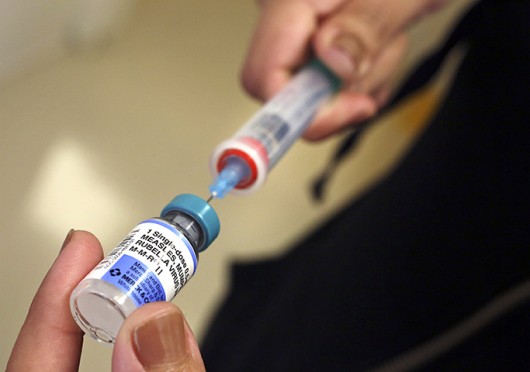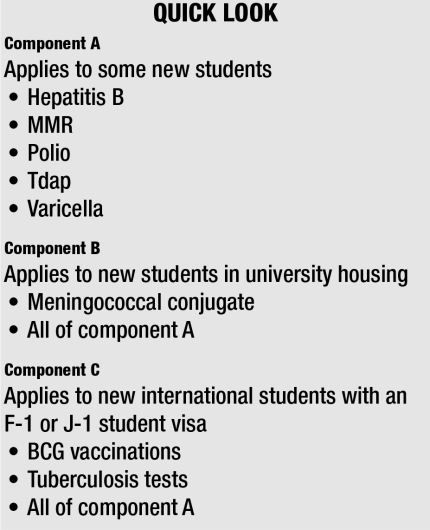
Student Health Services will require all new OSU students attending at least half-time, with at least one on-campus course scheduled, to be fully vaccinated effective this fall. Credit: Courtesy of TNS
Incoming first-year students who are not fully vaccinated might feel a slight sting Fall Semester as Ohio State implements a new approach to maintaining student health that changes the university’s vaccination recommendation to a requirement.
Student Health Services will require all new OSU students attending at least half-time, with at least one on-campus course scheduled, to be fully vaccinated.
The requirement applies only to new students at the Columbus campus and will not affect students enrolled prior to Fall Semester 2015 or students enrolled exclusively in distance learning courses.
Dr. Gladys Gibbs, director of Student Health Services, said the goal is to help ensure OSU student health by preventing disease instead of fighting it. She added that with next year’s freshman class being required to be vaccinated, the university will help ensure that most students will be vaccinated in four years.
“As a health care provider, I’m very excited,” Gibbs said. “We strive to keep our student population as healthy as they can be. It presents an opportunity to try to make sure that we’re supporting the health of our students to be their most successful as they matriculate.”
A hold will be placed on the accounts of students who fail to comply with each of the components’ vaccination requirements, according to the Student Health website.
The new vaccination requirements are based on recommendations by the Centers for Disease Control and Prevention.
Dr. William Martin, dean of the College of Public Health, said he wants OSU to be “a safe and healthy environment for all our students.”
“The way we do that is we initiate programs like vaccines, that are CDC recommendations, that help ensure the health and safety of our student population and the broader community,” Martin said.
New students will be required to submit vaccination documentation, which will then be reviewed for “completeness and compliance” and processed within 10 business days, according to the Student Health Services website.
Gibbs said it is too early to estimate how many students will require vaccinations through OSU, but said she is confident the Student Health Services can handle the demand. She said she expects the majority of new students to already be fully vaccinated because of the Ohio K-12 immunization requirements.
Martin said that, from a public health perspective, “vaccines are always the best buy.”
“It’s a relatively small investment to reduce susceptible individuals in a population,” Martin said. “Rather than have to deal with the consequences of serious and life-threatening infections, this is the opportunity, I think, to take a cohort of our OSU students and be certain, as best we can, that they will be protected, as will their neighbors.”
Ryan Robey, a fifth-year in history, said he thinks a vaccination requirement would help keep first-year students healthy, and, in turn, benefit the health of the rest of the student population.
“I think it would be a good idea for first-year students to be vaccinated,” he said. “Most first-year students live in dorms, and they’re going to come in close contact with other students on campus, at social gatherings and at places to eat.”
Jessica Hornish, a third-year in biology, said she thinks the requirement is a good approach to help ensure student health at OSU and help promote immunity on campus.
“From a personal standpoint, I’d feel safer,” she said. “Especially with all the sicknesses going around, I’d feel safer going to a school where the majority, if not all people, were vaccinated.”
Although Hornish views the requirements as a positive, she said she could see how some students might be apprehensive about the change.
Vaccination exemptions will be available to students with medical conditions that prohibit them from receiving one or more vaccination requirement. Students also are exempt if they show good cause, or object based on religious beliefs or philosophical or moral convictions.
The process of transforming vaccination recommendations into requirements began last year with an executive advisory committee, said Martin, who served as co-chair. He added that OSU moved forward with input from the CDC, the Ohio Department of Health, Columbus Public Health and experts in infectious disease and epidemiology at Wexner Medical Center.
Central Ohio experienced a mumps outbreak in 2014, with 255 cases at OSU. The 484 cases of mumps reported in the central Ohio outbreak surpassed the 438 reported cases in the U.S. in 2013.
Gibbs said the current vaccination practices of other universities, including some in the Big Ten, were surveyed during the process, though final decisions were based on what was expected to be best for OSU students specifically.
“There’s been a long track record at college campuses — students coming together, living in close proximity and being at risk — so I think most universities and colleges reconsider their current practices on a regular basis,” Martin said.



